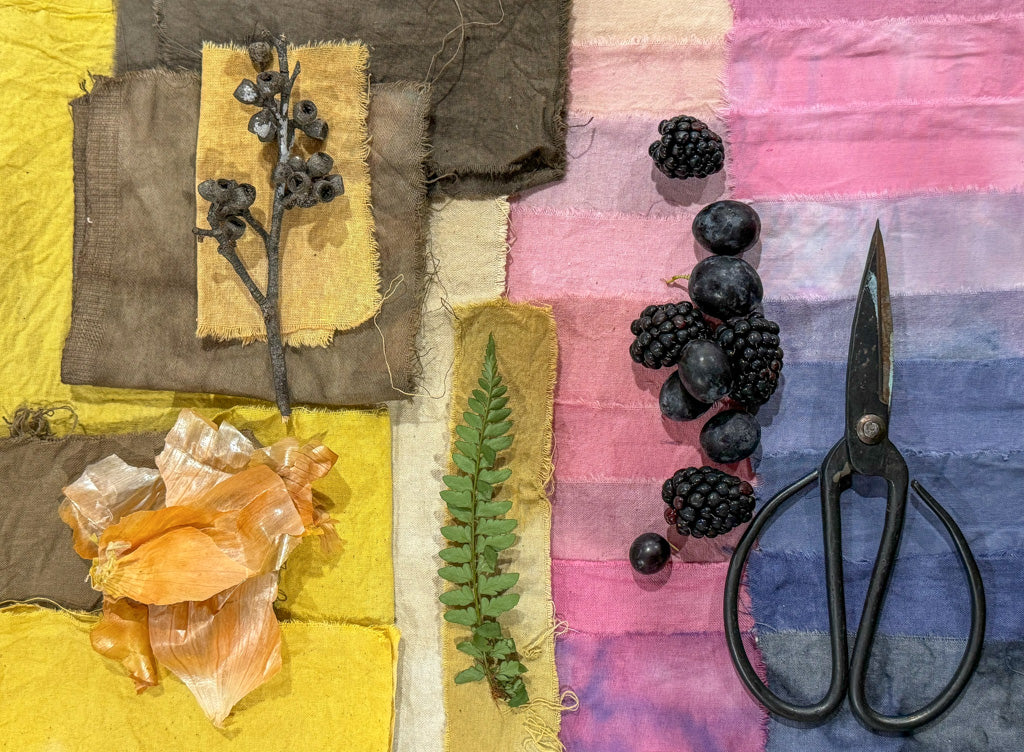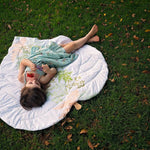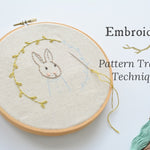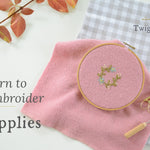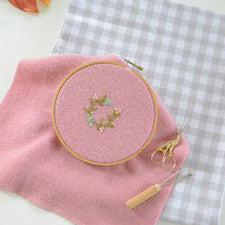We're so pleased to have Storyteller Ek Palmer joining us this month to share some of the knowledge she has gleaned from using wild foraged materials to dye fabric. We love Ek's relaxed, experimental approach to natural dyeing: experience, intuition, and an attitude of creative exploration have yielded colours so amazing, they could only come from nature!
Please note that this article reflects one fibre artist's experimental process of using wild-foraged plants to play with colour. Some materials may not produce a dye that is permanent or lightfast.



I still remember when I heard this quote for the first time, paraphrased by my aunt as she watched over us as we hunted, knee deep in mud, for things to grind into paint. Two filthy, wild haired kids with dreams of one day being able to buy ourselves fancy, beautiful paints.
Today, not too much has changed. I’m still a little wild, oft streaked with mud or paint and my hair is rarely in place. I still spend too much time creating or hunting in the mud and tall grass for things to make art. Perhaps just a little taller, a little older and a lot more tired as my two tiny humans bound alongside me, gleefully engrossed in the creative process with me. The one thing that has truly changed is that I no longer yearn for expensive paints and supplies, instead finding immense joy in the process: peace in the collection of wild berries for wild dye, serenity in grinding coloured stones into paints, delight in discovering a patch of wild clay. Thriving on that everyday magic. So today, come along with me. Open those glittering eyes, see this beautiful, wonderful world and share in the magic as we make some wild dye together.


There is a cooking term: “mise en place” a French phrase that refers to having everything pre measured, peeled, sliced and prepared before you begin. The wisdom of this concept for life in general, I think, cannot be understated. As teachers said to me many times, “Prior preparation prevents poor performance.” Unfortunately, being well prepared is not within my nature. However, it is much easier to follow along if you are not also flying by the seat of your pants, so let us begin with some artistic “mise en place”.
Tools: I am a firm believer in using what you have. A trip to the kitchen, or op-shop, will likely find you in good stead to begin your own wild-dyeing adventure. Tools I use most include:
- Pots
- Tongs
- Fine sieve
- Bowls
- Gloves
- Wooden spoons
- Stove
Of course, there are many more useful tools but this is a great place to start until you know what suits you best.
So, what fabric should you use? I use exclusively rejected fabrics, be it from an op-shop, saved from landfill or up-cycling clothing. Giving fabrics a new lease on life is a rewarding option. Look for organic fibres, Cellulose (plant based) and Protein (animal based) fibres work best though each have pros and cons.
Cellulose fibres such as cotton are more sturdy and can take more abuse, which is handy for a first time dyer, but will typically take the dye in more muted, dusky tones. Protein fibres such as wool or cashmere are more delicate and don’t handle high heat or neglect but give bright vibrant tones. If you’re unsure what your fabric is, follow this quick and easy rule: set it on fire!
- Proteins smoulder, leave a brown cinder and smell of burnt hair.
- Cellulose burns quickly, flames brightly, smells of burning paper and leaves white ash.
- Silks burn slowly, smell of burnt hair and leave only a small amount of cinder.
- Synthetics typically melt more-so than burn, smell of chemicals and form hard shiny beads.

Once you have identified your fabric the next step is scouring! Scouring is the preparation of fabrics to remove chemicals and oils that may prevent the dye from taking. Ideally when scouring use soft water to prevent streaking and keep colours even. However, I thrive on chaos and prefer to be surprised, so I mostly use hard bore water.
You can scour your fibres by washing on hot with soda ash, or boiling on the stove with 1tbs soap and 1 tbs soda ash until water is yellow. There are more advanced techniques but this is a great place to start. Just be mindful not to wash wool too hot in a machine to avoid felting.
Wild dye-stuff can be broken into two basic groups: those that need additional chemicals (mordants) to make them wash-fast (adjective dyes), and those that do not (substantive dyes). This information may be obtained via trial and error, or if you prefer a faster approach: Google. “Mordants” from the Latin “mordere” means “to bite” and are chemicals which allow the dye to “bite” the fibres, brightening and clarifying colours while making dyes wash-fast, you can skip this step if you don’t wish to wash your fibres but be mindful you will get lighter colours. Mordants can also change your colours so the same dye bath can give you a huge range with different mordants!

Take your scoured and dried fabric, weigh it and treat it according to the mordant you have chosen. Whichever mordant you have chosen will have it’s own process: Google, or books on natural dying from your local library can be wonderful resources! Alum is the most commonly used mordant and is as simple as dissolving a tablespoon of alum in a cup of warm water and pre-soaking your fabric or adding it to the dye bath.
Iron mordant is great as a colour modifier, changing colours into deep greens, greys and brown. Add some to your dye bath or quickly dip your dyed fabric and watch the magic! Iron mordant is easy to make, simply add rusty nails or some steel wool in a jar with 1part vinegar to 2part water and leave for a few days until it turns dark or rusty orange. Tannins in some plants like walnut can also act as a natural mordant allowing you to skip this step altogether.

Time for foraging for your dyes! There are exhaustive lists online of all the best dye plants, but the chaos in my soul loves the experimentation most of all. Take a joyful moment, grab your foraging satchel, head off into the shrub, the back yard or the local park and explore. Fruit and veggie skins, leaves, roots, flowers and berries, nuts, cones or even bark. Just be sure that your foraging doesn’t harm the environment. You will need roughly the same weight of dye-stuff as the weight of your fabric - less will still work, just give lighter colours.
Think of preparing your dye vat a bit like brewing the worlds biggest cup of tea: gentle handling will give you the brightest and clearest colours, heat will let you extract the colour, but too much heat will destroy it. Bright dyes come from long steeps and light colour from short steeps.
Every form of dye-stuff works best with a slightly different technique, but the general idea is as follows: clean and break up your dye-stuff, crush berries and grind roots. Add to a large pot, fill with water 3/4 of the way and gently heat for 30 min. Skins can handle being well simmered, leaves and roots need a delicate simmer. Flowers and berries are fragile, slowly heat to a light simmer. Nuts, cones and barks can handle a good boil.
Once the bath is at the appropriate simmer, drop the heat so it doesn’t boil and simmer for 1-2 hours. You may now wish to drain off your dye-stuff: leaving it in the bath can give better colours but can make them uneven where it touches the fabric, so choose your own adventure!
Next submerge your fabric and leave it on low heat for an hour, remove it from the heat and leave in the vat to cool - I usually wait overnight to two days depending on how impatient I’m feeling! Dispose of the spent dye in your garden or down the drain. Rinse till the water runs clear and hang to dry.

Consider keeping a journal of your experiments. Document the plant, time of year, even the location you found it, how you have prepared it and what mordants, modifiers, temperatures and time frames you used to achieve the different colours. Onion skins can produce ginger, light gold, beige, bright orange and more simply using different fabrics, modifiers and mordants. Even rinsing the fabrics out in high, neutral or lower ph water can impact the colour. Taking notes will help you figure out what works best for you!
Wild-dyeing is a fun and rewarding experience. You can do it with scales and measures, weighing everything to perfection and working with meticulous detail to get perfect results every time, or you can thrive on the chaos, measure with your heart and revel in the surprise of what is to come. Whichever way you choose to do it, the reward, I think, is in the journey. And so, I part from you with that very thought which started a young, wild, mud-covered me on my own journey of discovery: May your eyes glitter in your discovery of our beautiful world, may you find her greatest secrets, hidden in their unlikely places on your journey of creation.
Happy foraging wildlings.



